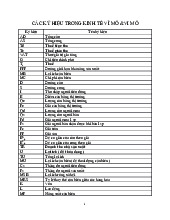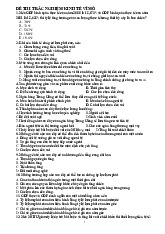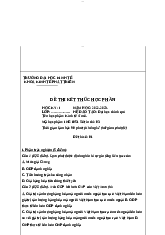



















Preview text:
lOMoARcPSD|45316467 lOMoARcPSD|45316467
THE IMPACT OF OFFICIAL DEVELOPMENT ASSISTANCE (ODA) ON
HUMAN DEVELOPMENT INDEX (HDI) IN SUB SAHARAN AFRICAN By
BERHANE , Amanuel Habtetsion THESIS Submitted to
KDI School of Public Policy and Management
In Partial Fulfillment of the Requirements For the Degree of
MASTER OF DEVELOPMENT POLICY 2017 lOMoARcPSD|45316467
THE IMPACT OF OFFICIAL DEVELOPMENT ASSISTANCE (ODA) ON
HUMAN DEVELOPMENT INDEX (HDI) IN SUB SAHARAN AFRICAN By
BERHANE , Amanuel Habtetsion THESIS Submitted to
KDI School of Public Policy and Management
In Partial Fulfillment of the Requirements For the Degree of
MASTER OF DEVELOPMENT POLICY 2017 Professor Yoon Cheong CHO lOMoARcPSD|45316467
The Impact of Official Development Assistance (ODA) on Human Development Index (HDI) 2 Table of Contents
List of Tables……………………………………………...………………………………………4
List of figures……………………………………………………………………………………...5
Acknowledgement………………………………………………………………………………...6
List of Abbreviations...……………………………………………………………………………7
Abstract ......................................................................................................................................................... 8
Chapter 1: Introduction................................................................................................................................. 9 1.1)
Introduction................................................................................................................................... 9 1.2)
Purpose of the study:................................................................................................................... 12 1.3)
Statement of the Problem............................................................................................................ 12 1.4)
Importance of the study: ............................................................................................................. 13 1.5)
Organization of the study:........................................................................................................... 13
Chapter 2: Literature Review...................................................................................................................... 14 2.1)
Foreign Aid and Economic Growth Literature Review .............................................................. 14 2.2)
Foreign Aid and Human Development Index (HDI) .................................................................. 16 2.3)
Official Development Assistance and Human Development Index in Africa ............................ 18 2.4)
Research questions:..................................................................................................................... 19
Chapter 3: Hypothesis Development .......................................................................................................... 20 3.1)
Dependent Variable .................................................................................................................... 21 3.1.1)
Human Development Index: ............................................................................................... 21 3.2)
Independent Variables................................................................................................................. 21 3.2.1)
Effects of ODA on HDI ...................................................................................................... 21 3.3)
Control Variables ........................................................................................................................ 22 3.3.1)
Effects of GDP per capital Annual growth on HDI ............................................................ 22 3.3.2)
Effects of Population Growth Annual on HDI.................................................................... 22 3.3.3)
Effects of Inflation on HDI ................................................................................................. 23 lOMoARcPSD|45316467
The Impact of Official Development Assistance (ODA) on Human Development Index (HDI) 3 3.3.4)
Effects of Institutions on HDI............................................................................................. 24 3.3.5)
Effects of Expenditure on Education and Health on HDI................................................... 25 3.3.6)
Effects of Military Expenditure on HDI ............................................................................. 25 3.3.7)
Effects of CO2 emissions (kg per 2011 PPP $ of GDP) on HDI ........................................ 26 3.3.8)
Effects of Personal remittances on HDI.............................................................................. 27 3.3.9)
Effects of Foreign direct investment (FDI) on HDI............................................................ 28
Chapter 4: Methodology ............................................................................................................................. 30 4.1)
Model .......................................................................................................................................... 31
4.2) Data ............................................................................................................................................. 35
Chapter 5: Data Analysis and Results......................................................................................................... 37 5.1)
Descriptive Statistics................................................................................................................... 37 5.2)
Scatter Diagram .......................................................................................................................... 38 5.3)
Data Analysis.............................................................................................................................. 39
Chapter 6: Conclusion and Policy Recommendation.................................................................................. 44 6.1)
Limitation of the study and future study..................................................................................... 47
Countries Considered in this Study............................................................................................................. 49
References................................................................................................................................................... 50 lOMoARcPSD|45316467
The Impact of Official Development Assistance (ODA) on Human Development Index (HDI) 4 List of Tables
Table 1: Dependent and Independent variables………………………………………………..30
Table 2: Descriptive statistics of HDI, ODA and other controlled variables………………….33
Table 3: Regression Results……………………………………………………………………35 lOMoARcPSD|45316467
The Impact of Official Development Assistance (ODA) on Human Development Index (HDI) 5 List of Figures
1) Scatter diagram of ODA and HDI…………………………………………………36 lOMoARcPSD|45316467
The Impact of Official Development Assistance (ODA) on Human Development Index (HDI) 6 Acknowledgements
Before all, I would like to give my limitless respect and gratitude to the almighty God who
gave me strength throughout the quest in this thesis. Then I would like to thank my advisor Prof.
Cho, Yoon Cheong for her invaluable and unreserved support and comment she provided me from
the title selection to the successful completion of this thesis.
I would also like to thank my families who gave me all round support in this journey. I
owe enormous debt to Global Ambassador for the financial assistance to enroll me in this program
and the KDI School of Public Policy and Management administration for their kind support. A
word of thanks also goes to all my professors who thought me various courses and classmates. lOMoARcPSD|45316467
The Impact of Official Development Assistance (ODA) on Human Development Index (HDI) 7 List of Abbreviations
HDI – Human Development Index
CPIA – Country’s Policy and Institutional Assessment
ODA – Official Development Assistance
DAC – Development Assistance Committee GDP – Gross Domestic Product GNI – Gross National Income
IMF – International Monetary Fund
FDI – Foreign Direct Investment CO2 – Carbon Dioxide
MDGs – Millennium Development Goals
NGOs – Non Governmental Organizations
UNDP – United Nations Development Program
OECD – Organization for Economic Co-operation and Development lOMoARcPSD|45316467
The Impact of Official Development Assistance (ODA) on Human Development Index (HDI) 8 Abstract
Sub Saharan African countries face challenges of massive poverty, lower economic
growth, huge international migration, epidemic diseases, low levels of education and health etc.
Governments of Sub Saharan African states do not have adequate finance to battle these
challenges successfully. Hence, billions of dollars in the form of foreign aid have been transferred
to solve the massive challenges. The objective of this study is to examine the impact of Official
Development Assistance (ODA) on Human Development Index (HDI) in 45 Sub Saharan African
Countries from 2000 up to 2014. The hypothesis that Official Development Assistance (ODA) has
positive significant impact on Human Development Assistance (HDI) has been tested using
Ordinary Least Square Regressions (OLS). The result shows ODA has no significant positive
impact on HDI. However, the finding of the study show net GDP, Institutions measured by CPIA
and personal remittances has significant positive effect on HDI, while population growth, military
expenditure as percentage of GDP and CO2 emissions has significant negative effect on HDI. lOMoARcPSD|45316467
The Impact of Official Development Assistance (ODA) on Human Development Index (HDI) 9 Chapter 1: Introduction 1.1) Introduction
Improving the life standards of African people by speeding the African development is one
of the biggest challenges of our times. Every year billions of dollars have been transferred from
Developed countries to Sub Saharan African countries to solve capital deficiency. Many
economists argue unlike the marshal plan which incredibly improved the European countries
economy by increasing capital formation, foreign aid in Africa has not played significant role in
solving the shortage of capital deficiency and alleviating poverty (Chenery & Strout, 1965)
According to the Millennium Development Goal report 2015 Sub Sahara Africa has shown
remarkable progress in achieving MDGs. However, the region still faces tremendous challenges
such as rapid growth of population, high levels of poverty and conflicts. Even though Sub Saharan
African showed impressive progress in poverty reduction since 1990s, the region still lags far
behind the other regions (MDGs 2015 Report). Currently 75% of the world’s poorest people live
in Africa (The Borgen Project 2015). More than 40% of the population in Sub Saharan African
still lives in extreme poverty less than $1.25 a day. Sub Sahara Africa remains with the highest
prevalence of undernourishment (MDGs 2015 Report). Moreover, currently Sub Sahara Africa has
the world’s highest child mortality rate, Maternal Mortality rate, highest illiteracy rate and HIV
infection rate (MDGs, 2016). Out of the global population who live without clean water, 37% live
in Sub Sahara Africa and 38% of the world’s refugees are located in Africa due to continuing
violence, conflict and widespread human rights violation (The Borgen Project 2015). This
statistics reflect the extent of low human development in Sub lOMoARcPSD|45316467
The Impact of Official Development Assistance (ODA) on Human Development Index (HDI) 10
Saharan African Countries. A low level of human development indicates the standards of living of
the Sub Saharan countries are poor.
Billions of dollars have been transferred to Sub Saharan African in the form of Official
Development Assistance. ODA “consists of disbursements of loans made on concessional terms
(net of repayments of principal) and grants by official agencies of the members of the
Development Assistance Committee (DAC), by multilateral institutions, and by non-DAC
countries to promote economic development and welfare in countries and territories in the DAC
list of ODA recipients” (World Bank, 2013).
Both donor and recipient countries doubt and question the significance of foreign aid on
economic growth in general and on poverty reduction in particular. For this reason several studies
have been conducted to testify the effectiveness of foreign aid on economic growth in developing
countries in general and in Sub Saharan African Countries in particular, however, the result was
mixed. Some studies show aid has positive impact on economic growth while the others concluded
it has negative or no impact on economic growth. For example, Papanek (1973), Dowling and
Hiemenz (1982), Gupta and Islam (1983), Hansen and Tarp (2000), Burnside and Dollar (2000),
Gomanee, et al. (2003), Dalgaard et al. (2004), and Karras (2006), discovered proof for positive
impact of foreign aid on growth. On the contarary Burnside and Dollar (2000) and Brautigam and
Knack (2004) come across evidence for negative impact of foreign aid and growth, while Mosley
(1980), Mosley, et al. (1987), Boone (1996), and Jensen and Paldam (2003) found proof to propose
that aid has no impact on growth.
Measuring the impact of ODA on economic growth is not a good indicator of
development. Because, economic growth is a single indicator, it does not show the life quality of
the population. It should be remembered that growth is a means to an end, but, not an end in its lOMoARcPSD|45316467
The Impact of Official Development Assistance (ODA) on Human Development Index (HDI) 11
own. As Amartya Sen notes, “Without ignoring the importance of economic growth, we must look beyond it” (Sen, 1999).
The United Nations Development Program developed a measure for aggregate human
wellbeing improvement which is called Human Development Index (HDI) (UNDP, 2010). HDI is
a composite measure of education index, health index and income index (UNDP 2010). Therefore,
HDI is the most comprehensive measurement of countries development both for social and
economic progress. It is therefore, important to evaluate the impact of foreign aid on Human
Development Index (HDI) to capture the overall progress of countries development (Sen, 1999).
Hence, this paper used UNDP measurement of Human Development Index as a proxy for
development. Over the past few decades a considerable research has been conducted in Sub
Saharan African. However, only few studies tried to look the impact of ODA on HDI in Sub
Saharan African region. Therefore, this paper focused to study the impact of ODA in Sub Saharan
African region. Sub Saharan African region is one of the poorest regions which are highly affected
by conflict, drought, disease and migration. Billons of dollar have been transferred to overcome
the conflict, drought, disease, migration and economic development since the start of foreign aid
to the region (World Bank 2015). Despite the huge transfer of foreign aid the region still lags far
behind any region in the world. Therefore, it is important to make an evaluation if ODA has a
positive impact on Human Development Index in Sub Saharan African region. lOMoARcPSD|45316467
The Impact of Official Development Assistance (ODA) on Human Development Index (HDI) 12 1.2) Purpose of the study:
The purpose of this thesis is to evaluate the impact of official development assistance
(ODA) on human development index (HDI) in the Sub Saharan African from the year 2000 up to
2014. Given ODAs effect on the Millennium Development Goals and other international
development goals, the effectiveness of official development assistance on improving economic
growth as a general and on human development index in a particular has been in a serious debate
in the past three decade (OECD 2014). The efficiency of ODA is usually measured by its impact
on GDP growth. However, it has been found that measuring the overall life improvement of
citizen’s needs comprehensive measures of wellbeing’s (Sen, 1999)
Therefore the objective of this study is to evaluate ODA impact on HDI (health, education
and income) in Sub Saharan African region of forty five countries. Moreover this paper
specifically focuses to see the impact of the ODA on HDI from the year 2000 till 2014 (after the
MDGs) to evaluate if MDGs has impact on HDI. 1.3)
Statement of the Problem
The objective of ODA is to improve the life standards of people of the developing
countries, different forms of foreign aid like program aid, project aid, emergency relief; technical
assistance etc has been transferring from developed countries to the developing countries starting
from the 1960s. Though few studies have studied the impact of ODA on HDI, no study has tested
after the MDGs. Therefore, the objective of this study is to test whether ODA has positive
contribution on HDI after MDGs. More over Sub Saharan African region is known for high
international illegal migration, famine, disease and conflicts. This shows us the life standard of the
people in Sub Saharan African is still at its low level. Hence, it is very important to conduct a lOMoARcPSD|45316467
The Impact of Official Development Assistance (ODA) on Human Development Index (HDI) 13
research on the impact of ODA on human development index, the drawbacks and strengthens of
ODA, future potential inflow of ODA to the region and identifies the necessary mechanisms
needed to be set by the recipient government and the donor in order to improve the HDI in the Sub Saharan African region. 1.4)
Importance of the study:
By evaluating the impact of ODA on HDI in Sub Saharan African region and analyzing its
limitations and strengthens the result of this paper may serve as a reference for future policy
makers in improving human development index and economic development. Moreover, the study
might be used as a reference for future study. 1.5)
Organization of the study:
The research paper is organized as follows. The first chapter includes the introduction part
of thesis, the second chapter reviews relevant literature in regards to ODA, economic growth and
HDI. The third chapter discusses the hypothesis development. Chapter four delineates the
methodological approach. In chapter five data analysis and findings will be discussed based on
empirical results. Finally the sixth chapter will exhibit the conclusion and policy recommendation of the study. lOMoARcPSD|45316467
The Impact of Official Development Assistance (ODA) on Human Development Index (HDI) 14
Chapter 2: Literature Review 2.1)
Foreign Aid and Economic Growth Literature Review
The aid effectiveness literature can be grouped in to three parts. The first part spans from
the start of Marshal Plan 1945s to 1950s, the aim of the aid was to reconstruct Europe, Japan and
win the cold war. European countries recovered quickly from the war turn economy and showed
significant economic progress (United States Agency for International Development, 1961).
In 1960s, the purpose of the foreign aid was for the development of the south (developing
countries) especially in infrastructure development. Both of the above literatures were directed by
the Harror-Domar growth theory, in which saving was considered the major driving force of the
economy by increasing investment and thereby growth (Hansen and Tarp, 2000). An evaluation of
the above theory proved that each dollar of foreign aid results an increase of one dollar in total
saving and investment Rosenstein-Rodan (1961) and Heller (1975). However, Rahman (1968),
Griffin and Enos (1970), and Weisskopf (1972) evaluation found that foreign aid increases
consumption and harms saving and investment. Hudson and Horrell (1987) found similar result
foreign aid and economic growth has no significant correlation.




